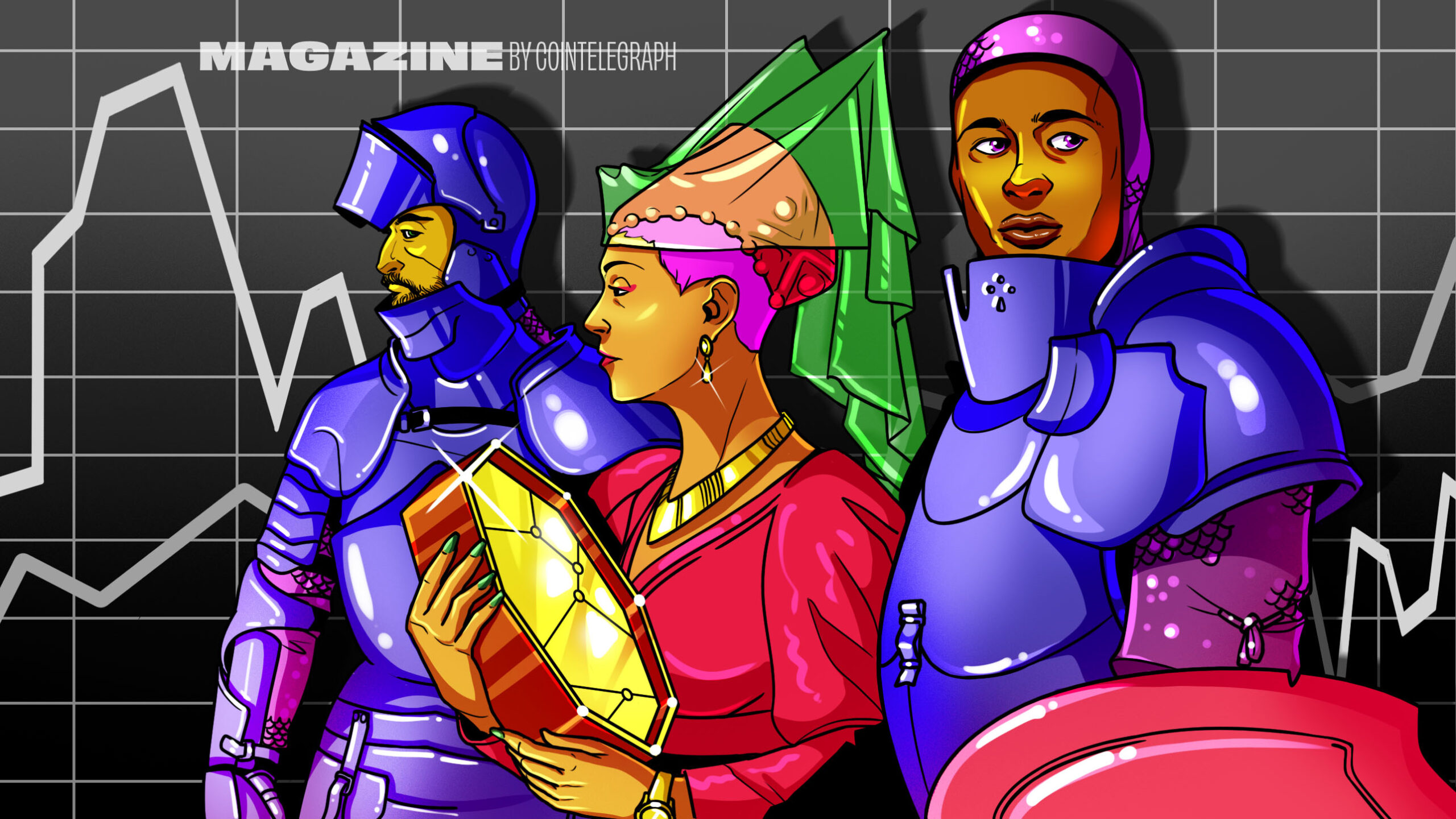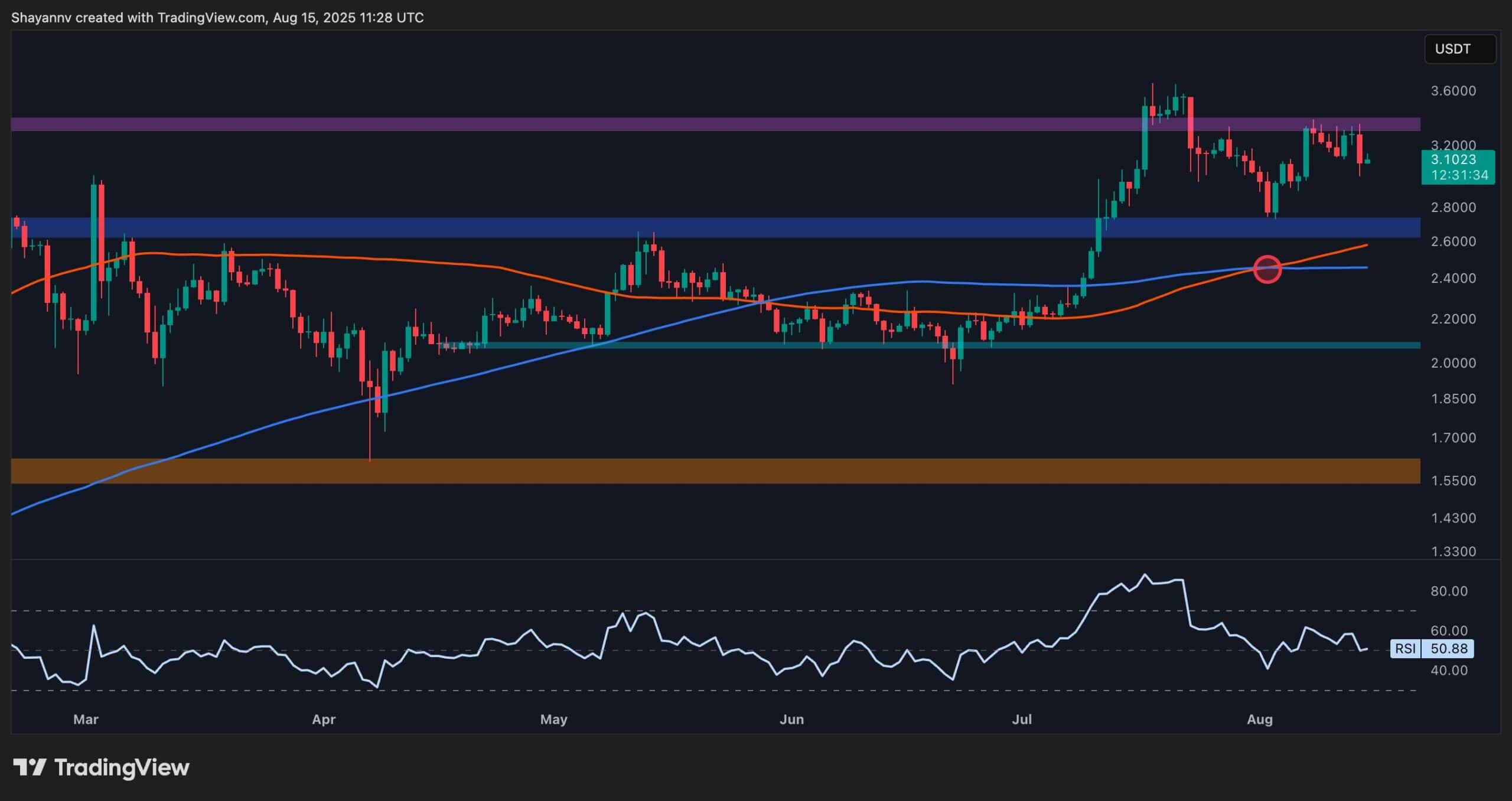Cryptocurrency
How to protect your crypto in a volatile market: Bitcoin OGs and experts weigh in

Crypto is a volatile place. Money can be as easily lost as made through the ups and downs of Bitcoin and the wider market, and there are massive decisions to make. Should you just hodl — invest and do nothing — or actively trade the market? How many coins should your portfolio hold? Self-custody or keep your funds on an exchange with pre-determined stop losses?
Basically, how do you protect your stack from the million and one things that can go wrong? We asked Bitcoin OGs and experts in the space for their advice and opinions.
Walk before you can run
When faced with the question of how best to protect your crypto, OG Brock Pierce is circumspect. The former presidential candidate and co-founder of Tether and Block.one points out that not everyone is in the same place.
“Early noobs looking to begin their journey might go to Coinbase and purchase their first $20 or $50 worth of crypto, and it’s not an investment in crypto, but an investment in yourself. However, the moment you have a material investment – and that is a different amount for everybody – then it’s important to understand the basics of hodling and investing in crypto,” he says.
“It’s always better to walk before you can run, to walk in baby steps and don’t let FOMO (fear of missing out) cloud your judgment. This is a marathon, a long game, so take you time and be informed.”
Self-custody for safety
Pierce repeats the mantra, “Not your keys, not your coins.” This is one of the most widespread pieces of wisdom in the world of crypto, where people are encouraged to take responsibility for holding their own crypto rather than outsourcing it to an exchange that can get hacked.
But there are dangers with this approach, too, and if something goes wrong, there is no centralized bank authority to reset the passwords or refund money lost to scams. It’s like holding cash under the mattress — the entire responsibility rests with you — and is referred to as self-custody in crypto.

Self-custody is the key to safe trading, according to Itai Avneri, deputy CEO and chief operating officer at INX Limited, the first and only fully regulated, end-to-end platform for listing and trading both SEC-registered security tokens and cryptocurrencies.
“Self-custody is the key here. Especially when thinking about digital securities and not just crypto. Trading on a centralized exchange that provides the confidence and protection of regulation and, at the same time, trading in a decentralized manner when the customer holds his / her own assets. Generally speaking, your wallet, your keys, your assets. This is the best way to protect yourself from a sudden hold on withdrawals or other events we witnessed in the past year,” Avneri says.
But Bitcoin billionaire Tim Draper of Draper VC says that while that’s true, institutions aren’t keeping funds on a Ledger in a drawer.
“I no longer believe that my dollars in the bank are very safe. They are subject to political winds and inflation,” he says.
“The safest personal money is BOL—Bitcoin on Ledger. The safest institutional money is BAC— Bitcoin at Coinbase,” Draper continues.

Diversification: Don’t just buy eggs
Pierce points out that people advanced in sophistication can look at investigating yield farming or decentralized finance. This allows people to not only protect their crypto but also to look at increasing it through earning yields — but again, this involves risk.
He emphasizes the importance of investing in your own education and notes the importance of diversification.

“If you are participating in those markets, then you by necessity take on the counterparty risk associated with those platforms, and how you mitigate those risks is through diversification, but not having all your eggs in one basket. If any one asset fell, it won’t wreck (rekt) your entire portfolio.”
Diversification in crypto is tricky, as Bitcoin and the rest of the market tend to move up and down at the same time. But Pierce warns against putting too much money in more volatile coins, for example, memecoins, in case of a downturn where the pain will be magnified.
Andrew Latham, a certified financial planner based in Rolesville, North Carolina and the director of content for financial websiteSuperMoney.com, echoes Pierce’s restraint and suggests looking outside of crypto as well.
“The key to surviving market downturns is diversification and a disciplined approach. Don’t put all your eggs in one basket. Spreading your investments across various asset classes can help cushion against volatility. Keep a disciplined approach to crypto investing, focusing on long-term goals over short-term market fluctuations.”
And while crypto investing is often a little bit too interesting for its good, he says successful investing is often the opposite.
“As the old adage goes, ‘Investing should be more like watching paint dry or watching grass grow. If you want excitement, take $800 and go to Las Vegas,’” Latham says.
High-conviction bets
Sometimes, it makes sense to be overweight in a blue chip, market-leading token though, as Warren Buffett’s 50% portfolio allocation to Apple shows. There are plenty of Bitcoin-only hodlers, but Lakov Levin, the co-founder of the new DeFi investment platform Locus Finance, leans heavily on Ethereum.
Levin suggests: “Ethereum is the blockchain, which is used as the fundament for the financial evolution of the 21st century. It is a hub for hundreds of protocols that build value for its users. Holding Ethereum is similar to holding a fraction of the internet and value it provides to users. It is truly a remarkable financial opportunity.”
Levin notes that Ethereum’s hodlers can stake their assets and receive 5% APR in ETH itself and points out the “Ethereum blockchain burns fees for each transaction made on the blockchain, which makes Ethereum a deflationary asset.”
“I do not think that ever in human history we saw a deflationary asset that generates consistent yield and has potential for such innovation,” concludes Levin.

A tool to stop losses
Pierce is sanguine about overall market dumps if you are positioned properly.
“If the market falls by 10%, take the hit using something like a stop loss, and try to recover in the next run.”
A stop-loss is a risk management tool that automatically sells a token once it reaches a certain floor – predetermined by the user. It is designed to limit losses but can be a blunt tool in the crypto world, where movements of 10% are common and could see all assets dumped as a result.

Levin is cautiously bullish on stop losses, which basically allow traders to close a trading position at a specific price.
“The effectiveness of any tool lies in the hands of those who use it. The most important thing about ‘stop losses’ is the feeling of control, which protects from the anxiety of being in the market.
One of the scenarios that stop losses is the management of hypotheses on market behavior. When entering a trade, a trader has a hypothesis of the behavior of the market, which leads to opening a trading position.
“Stop losses allow you to pick the price where your thesis is rejected by the market and limit your loss, which is a must thing to have for long-term trading. But ‘stop losses’ do not save from cognitive biases, which heavily affect trading. In this case, a trader may re-enter trade a few times, breaking his own rules under the influence of greed or fear. It is important to have discipline to follow your own rules.
“One of the rules that I used when trading is when hit by stop loss, I take a break from trading this asset,” says Levin.
Pierce is not an active trader and sees himself more as a long-term participant in the market. He appreciates that market volatility is not a negative thing and that tremendous wealth is made in volatile markets — the more movement, the more opportunity.
“But it’s not for the faint of heart. You know, you’re riding a roller coaster ride almost every day,” says Pierce.
Read also
Options can protect against extreme volatility
All-time highs – and all-time lows. Recent reports in The Wall Street Journal point to SpaceX writing down the value of its Bitcoin holdings by $373 million. It is currently unclear whether SpaceX sold or merely reduced the value of its digital assets in its accounts. This may cause difficulty in the future, as U.S. accounting rules dictate that once written down, the value of Bitcoin on company balance sheets cannot be adjusted upward, even if its price rises.
The subsequent downward movement took many by surprise — established investors and newbies alike. What other tools are available to users to protect their crypto? Well, a 50-year-old model created by Nobel-prize-winning professors could be an option.
Options trading gives the trader the right or obligation to buy or sell a specific security on a specific date at a specific price – it’s a contract that’s linked to an underlying asset such as a stock or security. Since 1973, options have been priced using the Black-Scholes model originally authored by two university professors. This mathematical equation estimates the theoretical value of assets based on implied volatility, taking into account the impact of time and other risk values. It is to this day regarded as one of the best ways to price an option contract.
Asked if he might consider using a tool like options, Pierce is cagey. He reckons that leverage is the demise of most people’s wealth. Leverage is the use of borrowed funds to increase one’s trading position beyond what would be available from one’s cash balance alone.
“Be very careful playing with leverage. It’s a tool for hedging to try and achieve great gains but can be the thing that creates more problems if you are not a skilled trader.”
Pierce has bought into options in the past – a few times where he tried to swing for the fences with leveraged option bets.
“It’s not worked out well, for me, because one of my problems is I’m so close to the market, that the markets are not as rational.”
Pierce quotes the recent SEC/Ripple legal action. He didn’t trade on this occasion, but if he had, he would have bet on an altcoin bull run.
“It didn’t happen. If I had followed my gut, then I would have bought and been wrecked the next day.”
As Pierce said, that’s why he’s not an active trader.
Stop losses and options?
A new protocol called Bumper is launching this month, claiming to provide a safety net for downward volatility. It combines stop losses and options in a way that co-founder Jonathan DeCarteret claims is cheaper and more efficient than both those traditional tools.

Bumper’s backtested economic simulations claim a yield improvement of 46.2% over options pricing during the 2022 bear market. This is demonstrated through a historic simulation report audited by Cryptecon and CADlabs.
“Decentralised Finance (DeFi) typically has low latency and high frequency of liquidity, which poses certain complexities for the model.
“Option desks make great use of pricing risk but have to add their costs on top. Bumper evolves the now half-century-old Black-Scholes equation to leverage all the unique properties of DeFi, such as pooled liquidity, smart contracts and protocol composability. Two years ago, we raised $20 million in funding to create a superior crypto equivalent,” says DeCarteret.
Don’t fall foul of criminal scams
The membership program Crytolock.ai enables users to save up to 90% of compliance and recovery expenses in case of a crypto breach. Not surprisingly, CEO Roger Ying says to focus on prevention, detection and recovery.

“Crypto users need to be educated on ways to prevent, secure and make sure they are not transacting with illicit entities otherwise, they may be implicated in a crypto crime,” he says.
“Furthermore, there are a growing number of ways to monitor your crypto on the blockchain and be immediately notified of unintended transactions and stop them before they get confirmed.” He adds that if you still end up the “victim of a hack or rug pull, understanding the necessary processes to recover crypto is very important both in time and expenditure savings.”
Hodling as a safe course
Of course, hodling large-cap cryptocurrencies is probably the safest and easiest way to maintain a position. Pierce recommends using cold storage provided by hardware wallets as a safe way to keep crypto.
Read also
“Back in the day when I started, we used paper wallets. You’d have a new device, and you’d print out the keys, laminate the paper, and chuck it into a safe.”
Sorkin is very direct in his hodling actions:
“Buy ETH, stake it in Lido, receive LDO and find ways to stake LDO. Otherwise just buy Bitcoin and forget about it completely until late 2024 when halving of BTC happens.”
Latham says the key to hodling is patience and conviction. “Invest only in cryptocurrencies that you believe have long-term potential and can withstand market downturns. Regularly review your holdings to ensure they still align with your investment goals. Time in the market does beat timing the market, but that only works when you pick cryptocurrencies that don’t flop, so it’s crucial to vet your investments carefully.”
Subscribe
The most engaging reads in blockchain. Delivered once a
week.

Cryptocurrency
Ethereum Foundation, Whales, and Hackers: What’s Driving the ETH Sell-Off?

TL;DR
- Whales, hackers, and the Ethereum Foundation wallets moved over $500M in ETH through large sales and withdrawals.
- Ethereum transfers rose to 4.6M ETH, nearing the monthly high of 5.2M recorded in July.
- Staking inflows hit 247,900 ETH, the highest in a month, locking more supply from trading.
Large Withdrawals and Whale Activity
Ethereum (ETH) has seen heavy movement from major wallets over the past few days. On-chain data from Lookonchain shows a newly created wallet pulled 17,591 ETH, worth $81.62 million, from Kraken in just two hours.
Over three days, two new wallets withdrew a combined 71,025 ETH, valued at $330 million, from the exchange.
One of these wallets, address 0x2A92, has withdrawn 53,434 ETH, worth $242.34 million, in two days. This includes a recent purchase of 30,069 ETH, valued at $138.46 million, during a market drop.
Major ETH Holders Offload Millions Amid Price Rally
In contrast, several separate entities have been disposing of some ETH holdings. A wallet tied to a hacker address 0x17E0 sold 4,958 ETH for $22.13 million at $4,463, securing a profit of $9.75 million. Earlier this year, the same address sold 12,282 ETH at $1,932 and later bought back part of the amount at higher prices.
A different whale sold 20,600 ETH for $96.55 million over the past two days, generating a profit of more than $26 million after holding the position for nine months.
Meanwhile, an Ethereum Foundation-linked wallet, 0xF39d, sold 6,194 ETH worth $28.36 million in the last three days at an average price of $4,578.
Recent sales from the same wallet included an additional 1,100 ETH and 1,695 ETH for over $12.7 million combined.
The #EthereumFoundation-linked wallet(0xF39d) sold another 1,300 $ETH($5.87M) at $4,518 ~11 hours ago.
Over the past 3 days, this wallet has sold a total of 6,194 $ETH($28.36M) at an average price of $4,578.https://t.co/4hfCWymHVG pic.twitter.com/ErUyEY8SJy
— Lookonchain (@lookonchain) August 15, 2025
Network Activity on the Rise
CryptoQuant data shows Ethereum’s total tokens transferred have been climbing since August 9. After ranging between 1 million and 3 million ETH through late July and early August, transfers have risen to 4.6 million ETH, approaching the monthly high of 5.2 million recorded in mid-July. This increase has occurred alongside a price rally from about $3,400 to $4,600.
Interestingly, staking inflows generally stayed between 20,000 and 80,000 ETH per day over the past month. On August 14, inflows jumped to 247,900 ETH, the highest in the period.
At the time, ETH was trading near $4,600. Large staking deposits reduce the amount of ETH available for immediate trading, as staked coins are locked for a set period.
In the meantime, ETH trades at $4,647 with a 24-hour volume of $68.25 billion, down 2% on the day but up 19% over the week.
Binance Free $600 (CryptoPotato Exclusive): Use this link to register a new account and receive $600 exclusive welcome offer on Binance (full details).
LIMITED OFFER for CryptoPotato readers at Bybit: Use this link to register and open a $500 FREE position on any coin!
Cryptocurrency
Massive DOGE Whale Activity Hints at $1 Breakout

TL;DR
- Whales bought two billion DOGE this week, lifting their combined holdings to 27.6 billion coins.
- A single 900M DOGE transfer worth $208M to Binance drew attention to large exchange movements.
- DOGE broke key resistance, with momentum building for a possible push toward the $1 price mark.
Price and Market Moves
Dogecoin (DOGE) traded at $0.23 at press time, slipping 4% over the past day but still showing a 2% gain for the week. Daily turnover came in at about $6.18 billion.
Meanwhile, the broader crypto market saw over $1 billion in liquidations. Hotter-than-expected US Producer Price Index data pushed traders to scale back expectations of a near-term Federal Reserve rate cut. DOGE had roughly 290,500 coins liquidated during the sell-off.
On the two-week chart, analyst Trader Tardigrade notes that DOGE has cleared a downward-sloping resistance line after completing what appears to be a “wave V” in an Elliott Wave sequence. Similar setups in the past, where prolonged declines stayed within falling channels before breaking higher, have been followed by sharp rallies.
$Doge/2-week#Dogecoin is gaining strong momentum to surge above $1 pic.twitter.com/TuSEKr19nv
— Trader Tardigrade (@TATrader_Alan) August 15, 2025
Momentum gauges are also turning up. The Stochastic RSI, which had dropped into oversold territory, is now heading higher. Previous reversals from this zone have coincided with sustained upward moves. The current formation points to a possible run that could carry DOGE past the $1 mark.
Heavy Whale Buying and Large Transfers
As reported by CryptoPotato, blockchain data shows large investors have added two billion DOGE in the past week, spending just under $500 million. That brings their holdings to about 27.6 billion coins, or 18% of the supply. The buying streak has prompted speculation within the community.
Recently, Whale Alert flagged a 900 million DOGE transfer worth about $208 million into Binance. The tracking indicates that it originated from a wallet connected to the exchange, likely as an internal activity. The address involved holds 2.88 billion DOGE, one of the largest balances on the network.
Ali Martinez also reports that transactions above $1 million reached a one-month high, with activity building since early August and peaking as DOGE traded at $0.25.
Whales are back! Dogecoin $DOGE activity at a 1-month high. pic.twitter.com/C83Pv68mCt
— Ali (@ali_charts) August 14, 2025
Sentiment Building
Analyst Gordon described the current setup as “a nice bit of consolidation” before a potential breakout, adding,
“This will be one of the first coins normies FLOCK to & the pump will be MASSIVE.”
With whale accumulation rising, high-value transfers increasing, and a bullish technical pattern in play, DOGE is positioned for a potential push toward $1 if momentum holds.
Binance Free $600 (CryptoPotato Exclusive): Use this link to register a new account and receive $600 exclusive welcome offer on Binance (full details).
LIMITED OFFER for CryptoPotato readers at Bybit: Use this link to register and open a $500 FREE position on any coin!
Cryptocurrency
Ripple Price Analysis: XRP at Risk as Key Support Levels Could Trigger Sharp Drop

XRP has recently entered a consolidation phase after a strong rally earlier this summer, with the price action now hovering around key resistance levels on both its USDT and BTC pairs. Yet, while momentum has slowed, the charts still indicate a generally bullish structure, with multiple key support levels remaining firmly in place.
Technical Analysis
By ShayanMarkets
The USDT Pair
On the XRP/USDT daily chart, the price is currently trading near the $3.10 mark, facing a strong resistance zone around $3.40. This follows a breakout above the $2.70 range in July, which has now flipped into a support area.
Both the 100-day and 200-day moving averages are also trending upward and recently formed a bullish crossover around $2.45, reinforcing the medium-term bullish sentiment. If the $3.40 resistance breaks, a push toward the critical $4.00 range becomes likely.
However, the RSI hovering near the neutral 50 level suggests a lack of strong momentum for now, meaning a short-term pullback into the $2.80 support zone is still possible.
This zone will be key for maintaining the bullish structure. Losing it could open the door for a deeper correction toward the 200-day moving average located around the $2.40 mark. Yet, as long as the price stays above the moving averages, the broader trend remains bullish.
The BTC Pair
Looking at the XRP/BTC chart, the pair has recently pulled back after hitting the 3,000 SAT resistance, with the price currently around 2,600 SAT.
This follows a clean breakout above the long-term descending channel and a successful retest of its upper boundary, which coincided with the 200-day moving average and the 2,400 SAT support zone. This confluence remains a key bullish technical factor, as holding above it could attract renewed buying pressure.
That said, RSI levels around 48 show that momentum has cooled after the sharp July rally, meaning XRP may continue ranging between 2,400 SAT and 3,000 SAT in the near term. A decisive close above 3,000 SAT would likely open the path to the 3,400 SAT zone, while losing 2,400 SAT could shift the bias back toward 2,000 SAT support. For now, the structure still favors the bulls as long as higher lows remain intact.
Binance Free $600 (CryptoPotato Exclusive): Use this link to register a new account and receive $600 exclusive welcome offer on Binance (full details).
LIMITED OFFER for CryptoPotato readers at Bybit: Use this link to register and open a $500 FREE position on any coin!
Disclaimer: Information found on CryptoPotato is those of writers quoted. It does not represent the opinions of CryptoPotato on whether to buy, sell, or hold any investments. You are advised to conduct your own research before making any investment decisions. Use provided information at your own risk. See Disclaimer for more information.
Cryptocurrency charts by TradingView.

 Forex3 years ago
Forex3 years agoForex Today: the dollar is gaining strength amid gloomy sentiment at the start of the Fed’s week

 Forex3 years ago
Forex3 years agoUnbiased review of Pocket Option broker

 Forex3 years ago
Forex3 years agoDollar to pound sterling exchange rate today: Pound plummeted to its lowest since 1985

 Forex3 years ago
Forex3 years agoHow is the Australian dollar doing today?

 Cryptocurrency3 years ago
Cryptocurrency3 years agoWhat happened in the crypto market – current events today

 World3 years ago
World3 years agoWhy are modern video games an art form?

 Commodities3 years ago
Commodities3 years agoCopper continues to fall in price on expectations of lower demand in China

 Economy3 years ago
Economy3 years agoCrude oil tankers double in price due to EU anti-Russian sanctions


























